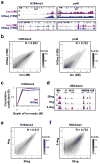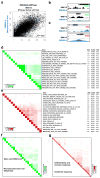Semiconductor-based DNA sequencing of histone modification states
- PMID: 24157732
- PMCID: PMC3917140
- DOI: 10.1038/ncomms3672
Semiconductor-based DNA sequencing of histone modification states
Abstract
The recent development of a semiconductor-based, non-optical DNA sequencing technology promises scalable, low-cost and rapid sequence data production. The technology has previously been applied mainly to genomic sequencing and targeted re-sequencing. Here we demonstrate the utility of Ion Torrent semiconductor-based sequencing for sensitive, efficient and rapid chromatin immunoprecipitation followed by sequencing (ChIP-seq) through the application of sample preparation methods that are optimized for ChIP-seq on the Ion Torrent platform. We leverage this method for epigenetic profiling of tumour tissues.
Conflict of interest statement
The authors declare no competing financial interests.
Figures


References
-
- Rothberg JM, et al. An integrated semiconductor device enabling non-optical genome sequencing. Nature. 2011;475:348–52. - PubMed
-
- Ferain I, Colinge CA, Colinge JP. Multigate transistors as the future of classical metal-oxide-semiconductor field-effect transistors. Nature. 2011;479:310–6. - PubMed
-
- Glenn TC. Field guide to next-generation DNA sequencers. Mol Ecol Resour. 2011;11:759–69. - PubMed
-
- Merriman B, Rothberg JM. Progress in ion torrent semiconductor chip based sequencing. Electrophoresis. 2012;33:3397–417. - PubMed
Publication types
MeSH terms
Substances
Associated data
- Actions
Grants and funding
- U54 HG003067/HG/NHGRI NIH HHS/United States
- P30 DK043351/DK/NIDDK NIH HHS/United States
- U01 CA1411508/CA/NCI NIH HHS/United States
- F32 CA168253/CA/NCI NIH HHS/United States
- R01 CA093947/CA/NCI NIH HHS/United States
- HHMI/Howard Hughes Medical Institute/United States
- P50 HG006193/HG/NHGRI NIH HHS/United States
- 1P50HG006193-01/HG/NHGRI NIH HHS/United States
- P50 CA093459/CA/NCI NIH HHS/United States
- DP1 OD003958/OD/NIH HHS/United States
- U54HG003067/HG/NHGRI NIH HHS/United States
- DP1OD003958-01/OD/NIH HHS/United States
- U01 CA141508/CA/NCI NIH HHS/United States
- R01 CA93947/CA/NCI NIH HHS/United States
LinkOut - more resources
Full Text Sources
Other Literature Sources
Medical
Molecular Biology Databases

